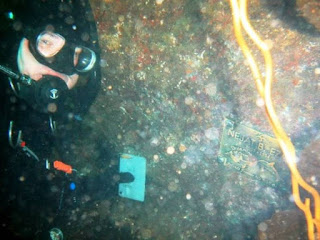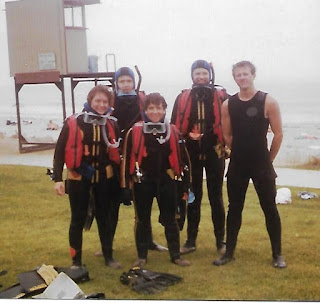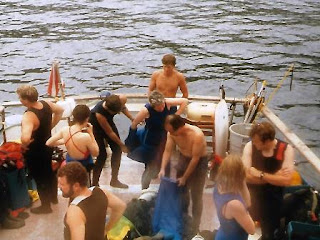Note: This story is a revised and updated version
of that published in as different blog. This versions had more graphics including video.
Scuba divers
encounter California sea lions often in Southern California. They dart around divers with a mesmerizingly dizzy
choreography. The liveliest encounters
that I experienced with the critters occurred at Anacapa and San Miguel Islands
Dale
Sheckler writing in California Diving
News observed:
Underwater, these animals are very
fast moving, precocious, and prone to mischief. They will zoom in right at your
face, sometimes blowing bubbles, roaring all the way. It is all at the same
time frightening, exhilarating, and fun.
Such encounters are truly special but
often don’t last long enough for elaborate study or photography. The best sea
lion encounters are those that last an entire dive. But that is tough to do.
Sea lions bore easily. They move in quick, check you out, then move off. To
keep them around for an entire dive you need to first go where the most sea
lions are and, more importantly, better understand their behavior and keep the
attention of these flighty speedsters of the deep that seem to be forever
suffering from “attention deficit disorder.”
This narrative
pretty much describes most of my encounters.
One memorable encounter happened while mapping the wreck of the Cuba at
San Miguel Island. One of them came from
above and tugged on my fin as a held a tape measure in place. I turned expecting to find my dive buddy only
to see the sea lion disappear into the kelp as if to say “gotcha” in an aquatic
version of ding, dong ditch.
When I moved
to Alaska, I had a brief encounter with one of their larger cousins, the
Steller sea lion. While diving with a group at Smitty’s Cove in Whittier a
solitary Steller did a quick swim by. If
I had been looking in a different direction, I might have missed it. Little did I know that was not how most encounters
with Steller sea lions unfolded.
Saturday, July 21, and Sunday, July
22, 2007, The Inian Islands, Southeast, Alaska
We anchored in a pass between two of the five islands that make up the Inian Island group just outside Glacie Bay Naional Park and north of the community of Elfin Cove. The scenery this clear July morning is nothing short of spectacular. I awaken early, grab a cup of coffee and head topside of the MV Nautilus Explorer to enjoy a wonderful panorama of the heavily wooded islands and the mountains beyond.

I am no
stranger to marine mammal encounters having been joined by California sea lions
on numerous dives. These experiences and critters are not similar, not even
close. The similarity ends with the words “sea lions” in their name. (Steller
sea lions are the only living members of the genus Emetopias; their closest
living relatives include other sea lions in the genus Zalophus which includes
the California sea lion.) Compared to their lower 48 west coast counterparts,
Steller sea lions are larger, more aggressive, and seem to have an attitude
that goes along with being the biggest and toughest critter on the rock.
A little
description sets the stage. Males can tip the scales at 2,500 pounds and
measure 11 feet in length, although the bachelor bulls we may encounter will
most likely weigh less than half that maximum (whew, that’s a relief). Females can weight up to 800 pounds andmeasure 9.5 feet in length. The
bachelor Steller sea lion is still larger than most full-grown California sea
lions. To put it in perspective, a half-ton Steller sea lion exceeds the
capacity and cargo space of most full-size pickup trucks. One guide book
describes the behavior of the Steller sea lion as “the species roars and growls
deeply rather than barking; sometimes swims by to inspect divers” and goes on
to describe California sea lions as “darker and smaller” than their Alaska
relatives.
After the
dive I concluded that the author of that book has a gift for misunderstatement.
If what I witness on this dive is a “swim by” then the Luftwaffe fighters going
after 8th Air Force bombers did a “fly by.” To top it off, there is no
agreement as to their name, various sources identify the critters as Steller
sea lions, Stellers sea lions, and Steller’s sea lions.
The First Encounter
I enter the
water with the last third of the divers reflecting more my station at the back
of the skiff rather than the luck of the draw. When I get to the bottom, I find
a rock in the kelp and used it as cover. Trouble is, at least two other divers
want to use the same rock so we get stacked up; but we decide to play well
together and take turns alternately cowering and looking up. This rock seems to
be a valuable piece of real estate and I consider selling it in a time share
scheme. Cautiously at first, the sea lions began to work the outer perimeter of
our group. Looking up, I see what looks like dozens of sea lions darting around
above in a quite stunning choreography of fur and fat. I take random pictures
with my Sony Cybershot digital camera as the situation allows, but in the
turbid green water figured all I would get is “shadows” of the sea lions as
they climb, dive, and loop-the-loop about us. I notice my buddy’s tank band has
come lose and the tank slipped down. I point out the situation to another diver
closer to her and he quickly repositions the tank and cinches the band tight.

Instantaneously,
as if on cue, the sea lions’ actions change. They move closer, abandoning any
pretense of turning away at the last minute. As if to “count coup,” the
critters begin “mouthing” the divers. The sea lions seem to mouth anything that
is exposed, which in the shelled up position most of us have assumed seems to
leave just our heads. The critters seem to come in waves rather than in a
constant frontal assault. The scene is a melee of cowering divers and plunging
sea lions. We are surrounded and outnumbered and I begin to wonder if this how Custer felt.
I see a diver in front of me get mouthed on the top of his
neoprene hood, a situation that reminds me of checking the ripeness of melons
in the grocery store produce section. I get the same treatment a few times on
the noggin, these are equal opportunity stalkers. One tugs hard at my regulator
hose; now it is getting personal; which means it is time to leave.
I join a
small group of divers heading to the surface. We make no safety stop. A few of
the sea lions detach from the main body and follow us up, although whether they
do so as an escort or to pick off stragglers I can’t say. They play a Border
collie role in that they keep the flock together.
A pretty
stiff current is running at the surface and some of us begin to drift away from
the skiff. The crew directs us to “swim toward the boat” as they are plucking
other divers out of the ocean. Kicking against the current, the best I can do
is slow the drift and wait for the skiff to motor over for the pick up.
Back on
board the Nautilus Explorer, I peel back my drysuit and discover the polar
fleece undergarment is damp. I figure that in craning my neck to watch the sea
lions, a trickle of water entered through the neck seal.
The Second Encounter
The next
day, we do an afternoon dive at a location the skipper has named “Bad Girls
Wall.” In the dive briefing, the skipper surmises that we will probably see more
sea lions on this dive, just not in the number we encountered the day before.
As we drift along the wall, the sea lions approach and dart away, seemingly
more curious and not exhibiting the belligerent aggressiveness evident on the
previous day’s dive. Except for their size, I would speculate these California
sea lions that strayed up the coast. My illusion and complacency startling
shatters at the end of my safety stop. A sea lion zips in and mouths my forearm
as if being offered the drumstick of a Thanksgiving turkey. (I should probably
be thankful he didn’t want a thigh or breast.) I am startled as its oral cavity
encompassed my drysuit-clad arm. I feel the squeeze but not much pressure. He
lets go and is gone as quickly as he arrived. The incident, which lasts all of
one or two breaths doesn’t last long enough for my surprise to progress to
astonishment.
Back on the
Nautilus Explorer, my dive buddy Lynn tells me that by happenstance he captured
the encounter up to the point of connected of the sea lion’s mouth around my
forearm. The video camera was running and he turned it off as we broke the
surface. As I watch the replay, I see the critter approach mouth wide open as
if it were about to rip into a salmon. I am pleased and relieved it knew the
difference. The last frame of the video is just prior to the point of contact,
making for a very dramatic visual.
I resolve to
sit out a dive that goes back to the rookery.
Steller sea lions have a reputation for being “the grizzlies of the sea”
and I don’t feel like poking the bear.
A few days
later, a visit to the Whale Museum at Telegraph Cove, British Columbia,
dramatically reinforces this point. The docent compares a Steller sea lion
scull side-by-side with that of a brown bear (as in grizzly bear for those of
you who don’t speak Alaskan or BC). The Steller skull dwarfs the brown bear’s
skull. She highlights another anatomical difference—the brown bear has both
incisors and molars reflecting his omnivore diet; the Steller sports only
incisors. Fortunately, I can look at the skull and teeth before me with the
disinterested detachment of someone who has looked into the jaws of the living
animal.
Is any of
the foregoing an exaggeration? If there is any doubt, I suggest you take the
plunge and find out for yourself.




















